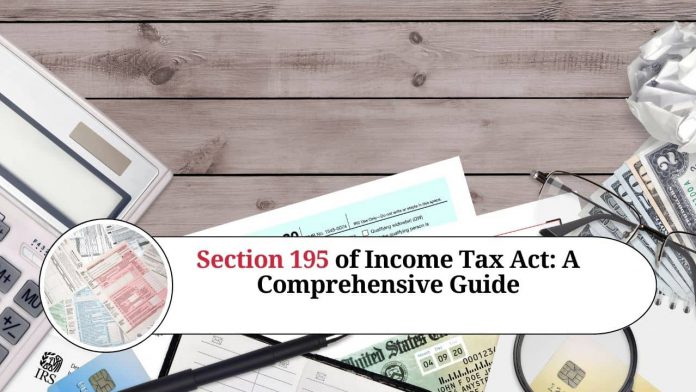Section 195 of the Income Tax Act pertains to the withholding tax obligation of a person responsible for paying any sum to a non-resident. This section is an essential aspect of the Indian income tax regime as it imposes an obligation on the payer to deduct tax at source (TDS) at the prescribed rates before making any payment to a non-resident. In this blog, we will discuss the key provisions of Section 195 of the Income Tax Act and its implications for taxpayers.
Applicability of Section 195
Section 195 applies to all persons responsible for paying any sum to a non-resident, including individuals, firms, companies, and other entities. The term non-resident refers to a person who is not a resident in India, as per the provisions of the Income Tax Act.
Tax Rates under Section 195
The tax rate applicable under Section 195 varies depending on the nature of the income and the residency status of the recipient. The rate of TDS is determined by the income tax authorities and may be subject to change from time to time. Currently, the standard rate of TDS under Section 195 is 20%.
However, in some cases, the tax rate may be lower, as per the provisions of the Double Taxation Avoidance Agreement (DTAA) between India and the country of the non-resident. In such cases, the lower rate of TDS may be applicable, subject to the conditions specified under the DTAA.
Provisions of Section 195
Section 195 requires the payer to deduct TDS at the time of making the payment to the non-resident or at the time of crediting the sum to the non-resident’s account, whichever is earlier. The TDS amount must be deposited with the government within the prescribed timeline, failing which the payer may be liable to pay interest and penalty.
Section 195 also mandates the payer to obtain a Tax Deduction Account Number (TAN) before deducting TDS under this section. Additionally, the payer must furnish a statement of TDS to the tax authorities in the prescribed format.
Exemptions under Section 195
Section 195 provides for certain exemptions from the obligation to deduct TDS. These exemptions are as follows:
- If the non-resident has obtained a certificate of non-deduction of tax from the tax authorities.
- If the sum payable to the non-resident is in the nature of capital gains arising from the transfer of a capital asset situated outside India.
- If the sum payable to the non-resident is in the nature of royalty or fees for technical services, and the non-resident does not have a permanent establishment in India.
- If the sum payable to the non-resident is in the nature of interest payable on a loan obtained from a foreign government or an international organization.
Conclusion
Section 195 of the Income Tax Act is a crucial provision that imposes an obligation on the payer to deduct TDS before making any payment to a non-resident. It is essential for taxpayers to comply with the provisions of this section to avoid any legal repercussions. Taxpayers must also be aware of the exemptions available under this section to avoid unnecessary TDS deductions.
Other Related Blogs: Section 144B Income Tax Act
Frequently Asked Questions (FAQs)
Q.1 What is Section 195 of the Income Tax Act?
Section 195 of the Income Tax Act pertains to the withholding tax obligation of a person responsible for paying any sum to a non-resident. It requires the payer to deduct tax at source (TDS) at the prescribed rates before making any payment to a non-resident.
Q.2 Who is required to comply with Section 195?
Section 195 applies to all persons responsible for paying any sum to a non-resident, including individuals, firms, companies, and other entities.
Q.3 What is the tax rate applicable under Section 195?
The tax rate applicable under Section 195 varies depending on the nature of the income and the residency status of the recipient. Currently, the standard rate of TDS under Section 195 is 20%. However, in some cases, the tax rate may be lower, as per the provisions of the Double Taxation Avoidance Agreement (DTAA) between India and the country of the non-resident.
Q.4 When is TDS to be deducted under Section 195?
TDS is to be deducted at the time of making the payment to the non-resident or at the time of crediting the sum to the non-resident’s account, whichever is earlier.
Q.5 Is it mandatory to obtain a Tax Deduction Account Number (TAN) before deducting TDS under Section 195?
Yes, it is mandatory to obtain a TAN before deducting TDS under Section 195.
Q.6 What is the timeline for depositing TDS with the government under Section 195?
The TDS amount must be deposited with the government within the prescribed timeline, which is typically within 7 days from the end of the month in which TDS was deducted.
Q.7 What happens if TDS is not deposited within the prescribed timeline?
If TDS is not deposited within the prescribed timeline, the payer may be liable to pay interest and penalty.
Q.8 Are there any exemptions from the obligation to deduct TDS under Section 195?
Yes, there are certain exemptions available under Section 195, such as if the non-resident has obtained a certificate of non-deduction of tax from the tax authorities or if the sum payable to the non-resident is in the nature of capital gains arising from the transfer of a capital asset situated outside India.
Q.9 Can the non-resident claim a refund of TDS deducted under Section 195?
Yes, the non-resident can claim a refund of the TDS deducted under Section 195 if the total income of the non-resident is below the taxable limit or if the tax liability of the non-resident is lower than the TDS amount.
Q.10 What are the consequences of non-compliance with Section 195?
Non-compliance with Section 195 can result in penalties, interest, and prosecution under the Income Tax Act.




















